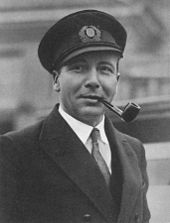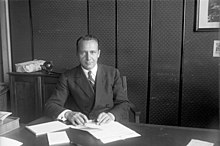Ernst A. Lehmann

Ernst August Lehmann (born May 12, 1886 in Ludwigshafen am Rhein ; † May 7, 1937 in Lakehurst ) was a well-known pioneer of airship travel , a military and civilian airship captain and one of the victims of the Lakehurst airship disaster in 1937 .
biography
Ernst Lehmann was the son of the Speyer- based BASF chemist and operations manager Dr. Ludwig Lehmann (1858–1939). In his home town of Ludwigshafen am Rhein, he attended the humanistic grammar school and graduated from high school in 1904. Here he sometimes went to the same class with Ernst Bloch . He then studied shipbuilding and marine engineering at the Technical University of Berlin-Charlottenburg from 1906 to 1912 and moved to the Kaiserliche Werft Kiel as a naval construction manager . In 1913 he was trained as an airship pilot by Hugo Eckener and in the same year took over the management of the Zeppelin LZ 17 "Saxony" . With this and other airships, Lehmann undertook reconnaissance and attack journeys on the fronts of Eastern and Western Europe during the First World War . During the war, the naval officer led the airships LZ 17 “Sachsen” (August 1, 1914 to December 1914), Z XII (January 1915 to October 1915), LZ 90 (January 1, 1916 to April 28, 1916), LZ 98 (April 28, 1916 to January 31, 1917) and LZ 120 (February 1, 1917 to September 1917).
In 1918 Lehmann joined the construction department of Luftschiffbau Zeppelin AG , headed by Eckener, and participated in the planning of future North Atlantic air traffic. From 1923 to 1927 he worked for the US Zeppelin subsidiary Goodyear-Zeppelin Corporation in Akron , Ohio . After his return, the man from Palatinate advanced to the position of authorized officer and assistant to Eckener, which is why he took part in numerous trips with the airship LZ 127 "Graf Zeppelin" , often in the capacity of the commander in charge.
Lehmann was on board as an observer for the management of the Deutsche Zeppelin-Reederei (DZR) during the last voyage of the airship LZ 129 "Hindenburg" when it burned on May 6, 1937, shortly before landing in Lakehurst . He died the following day from burn injuries. While still in the hospital, he expressed his incomprehension about the accident that had occurred and speculated that it must have been a “ hell machine ” that caused the airship to explode.
The seven Frankfurt victims were buried in a communal grave at the Frankfurt main cemetery. The tomb also serves as a memorial to the victims. It was built in 1939 by the sculptor Carl Stock , is now an honorary grave and is a listed building . According to the inscription on the memorial column, Fritz Flackus (Koch), Ernst Schlapp (electrician), Captain Ernst A. Lehmann (as an observer of the management of the Deutsche Zeppelin-Reederei), Alfred Bernhardt (helmsman), Franz Eichelmann (radio operator) were in the grave. , Willy Speck (first radio operator) and Max Schulze (steward) buried. Ernst Lehmann was originally buried there as part of a state funeral , but in 1939 he was transferred to Grassau ( Chiemgau ), where his son was already buried and where the widow had moved.
Ernst Lehmann published his aviator memoirs in 1936 under the title Auf Luftpatrouille und Weltfahrt . In it he characterized his Palatinate descent as the son of a BASF chemist:
“ I was raised with sulphurous acid and Palatinate wine. "
The Rheinpfalz , Ludwigshafen, reported on May 26th, 1999 in a commemorative article about Ernst Lehmann, that whenever he was on his way with the airship over his hometown, the majestically large Zeppelin gave a slight but clearly visible "bow" as a greeting to the Made home. This sight is unforgettable for old Ludwigshafen residents. He was also very musical and loved to entertain the passengers on board with his boatman's piano .
The Palatinate homeland poet Ludwig Hartmann rhymed about him:
" ... an unneccessary man full of strength and lard, Lehmann means unnaturally from de Palz! "
Honors
- The city of birth Ludwigshafen am Rhein named a street after the aviation pioneer.
- In the Zeppelin city of Friedrichshafen , Ernst-Lehmann-Strasse commemorates him , and a building erected by the Zeppelin Foundation is also on this street .
- Captain Lehmann-street or ring hot end roads in Bremen - Sebaldsbrück , Frankfurt , Neu-Isenburg - Zeppelinheim , Göttingen and airmen quarter in Landau were named after him.
- The towns of Burglengenfeld in Upper Palatinate and Bottrop as well as the municipality of Kressbronn on Lake Constance have each named a street after Captain Lehmann.
literature
- Ernst August Lehmann and Leonhard Adelt: On air patrol and world travel , Schmidt & Günther Verlag, Leipzig 1936 ( digitized ).
- Max Geisenheyner: EA Lehmann Zeppelin-Captain , Societäts-Verlag, Frankfurt 1937.
- Rolf Italiaander : Lehmann, Ernst August. In: New German Biography (NDB). Volume 14, Duncker & Humblot, Berlin 1985, ISBN 3-428-00195-8 , p. 77 f. ( Digitized version ).
- Viktor Carl: Lexicon of Palatinate personalities. Hennig Verlag, Edenkoben 2004, ISBN 3-9804668-5-X , pp. 511-512.
Web links
- Literature by and about Ernst A. Lehmann in the catalog of the German National Library
- Newspaper article about Ernst A. Lehmann in the 20th century press kit of the ZBW - Leibniz Information Center for Economics .
- Faces of the Hindenburg: Captain Ernst A. Lehmann (English)
Individual evidence
- ^ Carsten Reinhardt: Research in the chemical industry: the development of synthetic dyes at BASF and Hoechst, 1863 to 1914 . Technische Universität Bergakademie, 1997, ISBN 978-3-86012-049-1 ( google.de [accessed on October 2, 2019]).
- ^ Memorial to the Hindenburg airship accident in Lakehurst (USA) on May 6th, 1937. frankfurter-hauptfriedhof.de, accessed on November 11, 2019 .
- ↑ Bettina Erche: Frankfurt main cemetery . Supplementary volume on the monument topography of the city of Frankfurt am Main. Henrich, Frankfurt am Main 1999, ISBN 3-921606-35-7 , p. 424 .
- ↑ In 1937 the German airship journey died in America ( Memento from February 13, 2012 in the Internet Archive ), traunsteiner-tagblatt.de , 24/2007.
- ↑ see Faces of the Hindenburg
- ↑ In the Zeppelin Wagner operas on the Schifferklavier , commemorative article to Ernst Lehmann, Die Rheinpfalz , local part Ludwigshafen, May 26, 1999.
- ^ Geschichtspfad Friedrichshafen # Former single home - plate 4.10
- ↑ Captain-Lehmann-Straße in Landau in the Palatinate
| personal data | |
|---|---|
| SURNAME | Lehmann, Ernst A. |
| ALTERNATIVE NAMES | Lehmann, Ernst August (full name) |
| BRIEF DESCRIPTION | Airship captain and zeppelin builder |
| DATE OF BIRTH | May 12, 1886 |
| PLACE OF BIRTH | Ludwigshafen am Rhein |
| DATE OF DEATH | May 7, 1937 |
| Place of death | Lakehurst |



